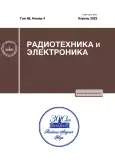Application of Heat Treatment to Optimize the Magnetostrictive
- Authors: Ivasheva E.E.1, Leontiev V.S.1, Bichurin M.I.1, Koledov V.V.2
-
Affiliations:
- Yaroslav-the-Wise Novgorod State University
- Kotelnikov Institute of Radioengineering and Electronics of RAS
- Issue: Vol 68, No 4 (2023)
- Pages: 396-398
- Section: К 90-ЛЕТИЮ ВЛАДИМИРА ГРИГОРЬЕВИЧА ШАВРОВА
- URL: https://journals.rcsi.science/0033-8494/article/view/138203
- DOI: https://doi.org/10.31857/S0033849423040034
- EDN: https://elibrary.ru/PETZWT
- ID: 138203
Cite item
Full Text
Abstract
The heat treatment effect of the magnetostrictive component in magnetoelectric (ME) composites consisting of a piezoelectric and magnetostrictive material has been studied. The dependence of the ME voltage coefficient on frequency was experimentally found without heat treatment and with annealing from 200 to 500°C of the AMAG493 amorphous alloy, which acted as a magnetostrictive component. It is shown that with an increase in the processing temperature of an amorphous alloy, an increase in the ME voltage coefficient is observed: the maximum value of the ME coefficient was observed at a temperature of 350°C and amounted to 29.52 V cm–1 Oe–1 at a resonance frequency of 54 kHz. It has been proven that the increase in the ME voltage coefficient occurs due to the improvement in the characteristics of the amorphous alloy during heat treatment, which leads to partial nanocrystallization of the material.
About the authors
E. E. Ivasheva
Yaroslav-the-Wise Novgorod State University
Email: ellen9879@yandex.ru
Veliky Novgorod, 173001 Russia
V. S. Leontiev
Yaroslav-the-Wise Novgorod State University
Email: ellen9879@yandex.ru
Veliky Novgorod, 173001 Russia
M. I. Bichurin
Yaroslav-the-Wise Novgorod State University
Email: ellen9879@yandex.ru
Veliky Novgorod, 173001 Russia
V. V. Koledov
Kotelnikov Institute of Radioengineering and Electronics of RAS
Author for correspondence.
Email: ellen9879@yandex.ru
Moscow, 125009 Russia
References
- Bichurin M.I., Petrov V.M., Petrov R.V., Tatarenko A.S. Magnetoelectric Composites. Singapore: Pan Stanford Publishing Pte. Ltd., 2019.
- Nan C.-W., Bichurin M.I., Dong S. et al. // J. Appl. Phys. 2008. V. 103. № 3. P. 031101. https://doi.org/10.1063/1.2836410
- Wang Y., Gray D., Berry D. et al. // Adv. Mater. 2011. V. 23. № 35. P. 4111. https://doi.org/10.1002/adma.201100773
- Bichurin M., Petrov R., Sokolov O. et al. // Sensors. 2021. V. 21. № 18. P. 6232. https://doi.org/10.3390/s21186232
- Wang Y., Li J., Viehland D. // Mater. Today. 2014. V. 17. № 6. P. 269. https://doi.org/10.1016/j.mattod.2014.05.004
- Dong S., Liu J.-M., Cheong S.W., Ren Z. // Adv. Phys. 2015. V. 64. № 5–6. P. 519. https://doi.org/10.1080/00018732.2015.1114338
- Palneedi H., Annapureddy V., Priya S., Ryu J. // Actuators. 2016. V. 5. № 1. Article No. 5010009. https://doi.org/10.33990/act5010009
- Chu Z., Pourhosseiniasl M., Dong S. // J. Phys. D Appl. Phys. 2018. V. 51. № 24. P. 243001. https://doi.org/10.1088/1361-6463/aac29b
- Leung C.M., Li J., Viehland D., Zhuang X. // J. Phys. D Appl. Phys. 2018. V. 51. № 26. P. 263002. https://doi.org/10.1088/1361-6463/aac60b
- Deng T., Chen Z., Di W. et al. // Smart Mater. Struct. 2021. V. 30. № 8. P. 085005. https://doi.org/10.1088/1361-665X/ac0858
- Katakam S., Hwang J.Y., Vora H. et al. // Scripta Mater. 2012. V. 66. № 8. P. 538. https://doi.org/10.1016/j.scriptamat.2011.12.028
- Jiang W.H., Atzmon M. // Scripta Mater. 2006. V. 54. № 4. P. 333. https://doi.org/10.1016/j.scriptamat.2005.09.052
- Datta A., Nathasingh D., Martis R.J. et al. // J. Appl. Phys. 1984. V. 55. № 6. P. 1784.https://doi.org/10.1063/1.333477











